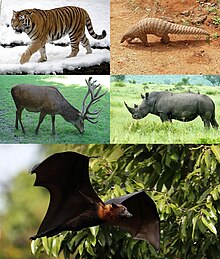Scrotifera
| Scrotifera Temporal range:
| |
|---|---|

| |
| From top to right:tiger,Indian pangolin,red deer,white rhinoandLyle's flying fox.Representing the living orders:Carnivora,Pholidota,Artiodactyla,PerissodactylaandChiroptera,comprising Scrotifera. | |
| Scientific classification | |
| Domain: | Eukaryota |
| Kingdom: | Animalia |
| Phylum: | Chordata |
| Class: | Mammalia |
| Superorder: | Laurasiatheria |
| Clade: | Scrotifera Waddell et al., 1999[1] |
| Subgroups | |
| |
| Synonyms | |
| |
Scrotifera( "scrotum bearers" ) is acladeofplacental mammalsthat groups together grandorderFerungulata,Chiroptera(bats), other extinct members and their common ancestors. The clade Scrotifera is a sister group to the orderEulipotyphla(true insectivores) based on evidence frommolecular phylogenetics,[1]and together they make superorderLaurasiatheria.Thelast common ancestorof Scrotifera is supposed to have diversified ca. 73.1[3]to 85.5[4]million years ago.
Etymology
[edit]Peter Waddell, then of theInstitute of Statistical Mathematics,explains the etymology of the clade's name as follows:
The name comes from the wordscrotum,a pouch in which thetestespermanently reside in the adult male. All members of the group have a postpenile scrotum, often prominently displayed, except for some aquatic forms andpangolin(which has the testes just below the skin). It appears to be an ancestral character for this group, yet other orders generally lack this as an ancestral feature, with the probable exception ofPrimates.[1]
Classification and phylogeny
[edit]History of phylogeny
[edit]In2006,the cladePegasoferae(a clade of mammals that includes orders Chiroptera,Carnivora,PerissodactylaandPholidota) was proposed as part of the clade Scrotifera and a sister group to the orderArtiodactyla,based on genomic research in molecular systematics.[5]The monophyly of the group is not well supported, and recent studies have indicated that this clade is not a natural grouping.[4][6]
According to a 2022 study, two extinct species (Eosoricodon terrigenaand"Wyonycteris" microtis) were identified as outside of the familyNyctitheriidaeand more closely related mammals to bats.[7]In another 2022 study, the extinct genusAcmeodonwas recognized as not a member of the extinct orderCimolestabut a basallaurasiatherianmammal in the clade Scrotifera.[8][9]
Taxonomy
[edit]Former classification: Current classification: - Clade:Scrotifera(Waddell, 1999)
- Order:Artiodactyla(Owen, 1848)(even-toed ungulate)
- Clade:Pegasoferae(Nishihara, 2006)
- Order:Chiroptera(Blumenbach, 1779)(bats)
- Clade:Zooamata(Waddell, 1999)
- Miroder:Ferae(Linnaeus, 1758)
- Order:Perissodactyla(Owen, 1848)(odd-toed ungulate)
- Clade:Scrotifera(Waddell, 1999)
- Grandorder:Ferungulata(Simpson, 1945)
- Clade:Chiroptera(bats)
- Family: †Eosoricodontidae(Lopatin, 2005)
- Genus: †Acmeodon(Matthew & Granger, 1921)
- Genus: †Gelastops(Simpson, 1935)
- Incertae sedis:
- †"Wyonycteris" microtis(Secord, 2008)
- Clade:Scrotifera(Waddell, 1999)
See also
[edit]References
[edit]- ^abcWaddell, Peter J.; Cao, Ying; Hauf, Jöerg; Hasegawa, Masami (1 March 1999). Olmstead, R. (ed.)."Using Novel Phylogenetic Methods to Evaluate Mammalian mtDNA, Including Amino Acid-Invariant Sites-LogDet plus Site Stripping, to Detect Internal Conflicts in the Data, with Special Reference to the Positions of Hedgehog, Armadillo, and Elephant".Systematic Biology.48(1): 31–53.doi:10.1080/106351599260427.ISSN1076-836X.PMID12078643.
- ^Springer M. S., Murphy W. J., Eizirik E., O'Brien S. J. In: "Placental Mammals: Origins and Relationships of the Major Clades." Rose K. D., Archibald J., editor. Baltimore: Johns Hopkins; (2005.) "Molecular evidence for major placental clades"; pp. 37–49
- ^dos Reis, Mario; Inoue, Jun; Hasegawa, Masami; Asher, Robert J.; Donoghue, Philip C. J.; Yang, Ziheng (7 September 2012)."Phylogenomic datasets provide both precision and accuracy in estimating the timescale of placental mammal phylogeny".Proceedings of the Royal Society B: Biological Sciences.279(1742): 3491–3500.doi:10.1098/rspb.2012.0683.ISSN0962-8452.PMC3396900.PMID22628470.
- ^abZhou, Xuming; Xu, Shixia; Xu, Junxiao; Chen, Bingyao; Zhou, Kaiya; Yang, Guang (1 January 2012)."Phylogenomic Analysis Resolves the Interordinal Relationships and Rapid Diversification of the Laurasiatherian Mammals".Systematic Biology.61(1): 150–64.doi:10.1093/sysbio/syr089.ISSN1063-5157.PMC3243735.PMID21900649.
- ^Nishihara, H.; Hasegawa, M.; Okada, N. (2006)."Pegasoferae, an unexpected mammalian clade revealed by tracking ancient retroposon insertions".Proceedings of the National Academy of Sciences.103(26): 9929–9934.doi:10.1073/pnas.0603797103.PMC1479866.PMID16785431.
- ^Tsagkogeorga, G.; Parker, J.; Stupka, E.; Cotton, J. A.; Rossiter, S. J. (2013)."Phylogenomic analyses elucidate the evolutionary relationships of bats (Chiroptera)".Current Biology.23(22): 2262–2267.doi:10.1016/j.cub.2013.09.014.PMID24184098.
- ^Matthew F. Jones, Nancy Simmons, K. Christopher Beard (2022.) "Relationship of nyctitheres (Mammalia, Nyctitheriidae) to bats and other laurasiatherians", in"The Society of Vertebrate Paleontology 82nd annual meeting"
- ^Bertrand, O. C.; Shelley, S. L.; Williamson, T. E.; Wible, J. R.; Chester, S. G. B.; Flynn, J. J.; Holbrook, L. T.; Lyson, T. R.; Meng, J.; Miller, I. M.; Püschel, H. P.; Smith, T.; Spaulding, M.; Tseng, Z. J.; Brusatte, S. L. (2022)."Brawn before brains in placental mammals after the end-Cretaceous extinction".Science.376(6588): 80–85.Bibcode:2022Sci...376...80B.doi:10.1126/science.abl5584.hdl:20.500.11820/d7fb8c6e-886e-4c1d-9977-0cd6406fda20.
- ^Bertrand, O. C.; Jiménez Lao, M.; Shelley, S. L.; Wible, J. R.; Williamson, T. E.; Meng, J.; Brusatte, S. L. (2023)."The virtual brain endocast ofTrogosus(Mammalia, Tillodontia) and its relevance in understanding the extinction of archaic placental mammals "(PDF).Journal of Anatomy.doi:10.1111/joa.13951.PMID37720992.S2CID262047180.
